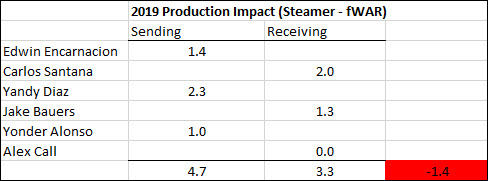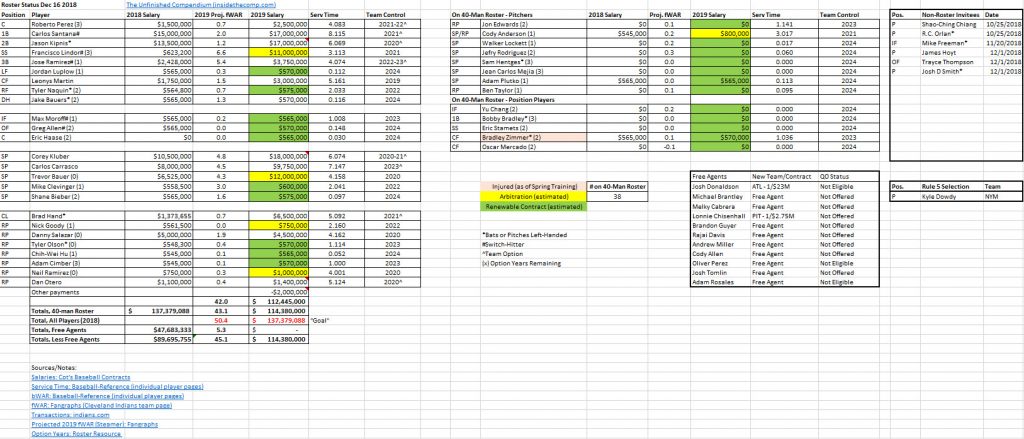Over the past several days, the Indians have made further moves to restructure their roster. Before diving into things any deeper, the actual moves, along with the financial aspects of those deals if relevant:
Trade 1a: Traded 1B/DH Edwin Encarnacion ($25M 2019) and 2019 #77 Draft Pick to the Seattle Mariners for 1B/DH Carlos Santana ($17.5M 2019, $18M 2020) and $6M ($2M in 2019, $4M in 2020)
Trade 1b: Traded 3B/1B Yandy Diaz and RHP Cole Sulser (AAA) to the Tampa Bay Rays for 1B/OF Jake Bauers
Trade 2: Traded 1B Yonder Alonso ($9M 2019) to the Chicago White Sox for OF Alex Call (A+)
(All salary/financial information is from Cot’s Contracts)
I’ve separated the 3-way trade between the Indians, Mariners and Rays into two separate deals because in essence that’s what they are. The only thing changing hands between the Mariners and Rays is $5M, apparently to bridge the gap between their valuations of Bauers and Diaz.
Trade 1a is a trade of large salaries, with the Mariners taking on more this year in exchange for almost nothing to pay out next year (save the $4M to Cleveland), while the Indians commit to $14M for Santana next year in order to take $9.5M off their payroll this year. In addition, Santana can play first base everyday, freeing up the DH spot for some other player or players as the offseason progresses. And of course there’s the side benefit of bringing back a player that liked being in Cleveland, and who was liked by his teammates. Steamer projects that the Indians will have the better 1B/DH next year, and moving back to the American League won’t hurt Santana’s production either.
Trade 1b has a less obvious justification. In trading Yandy Diaz, the Indians seem to be dealing a player on the cusp of breaking into a full-time role, a player that has a unique set of skills in today’s game: a ground-ball stroke combined with an incredible bat speed. Even if Yandy never hits for home run power could easily make a career for himself as a top-of-the-order hitter. His profile fits better in the 1910s than in 2010s, but even today I think he can make a career for himself. He’s going into his Age 28 season, but I think that makes him quite a bit for valuable to the Rays given that if he does break out, he’ll be under team control throughout his prime years. Bauers is 5 years younger than Diaz, but is likewise on the cusp of playing every day in the majors. Given the Indians’ desperate need in the outfield, Bauers could play in left and right field, but ultimately I think he’s the first baseman of the future.
As for the Alonso deal, it’s almost a carbon copy of the Yan Gomes trade. The goal was to have someone take on Alonso’s 2019 salary (and perhaps even his 2020 salary if his option vests), and with the White Sox are very interested in landing Manny Machado, the opportunity to acquire his brother-in-law was apparently appealing even with the price tag. The prospect the Indians received in return will not help the team this year, or probably next year. But again, the major return in the deal is the $9M that the Indians won’t be paying Alonso.
Here’s a couple key quotes from Chris Antonetti about the trades this week.
Chris Antonetti, on Carlos Santana and Jake Bauers (indians.com)
“First off, I think we’re acquiring two players that we feel will help us next year,” Antonetti said. “Both Carlos and Jake are productive Major League players that not only contribute but enhance the versatility of our roster. Beyond that, it adds some payroll flexibility for us in 2019.”
Antonetti on the makeup of the current roster (this was before the Alonso trade)
“So we could configure the roster in a variety of different ways. But there’s still a lot of offseason left. I’m not sure this will be the final roster that we have going into Spring Training.”
Antonetti, after the Alonso trade (indians.com)
“It’s still relatively early in the offseason,” Antonetti said. “So I think what we will continue to do is be aggressive — taking opportunities to improve our position moving forward. Whether that’s a 2019 impact or it’s gonna help us sustain success beyond 2019, we’ll have to see what opportunities present themselves.”
To summarize the financial aspects of the deals:


Given that the market value of 1.0 WAR (wins above replacement) is between $8-9M, the Indians did well here if you look strictly at payroll and projected production. They did lose 1.4 wins as a result of the two trades, but dropped $18.5M in the process. They could easily buy those 1.4 wins back on the free agent and still have some of the savings left over.
But it isn’t just about total payroll and total production. There’s also the roster configuration to think about. By trading several starters from last year, along with a projected starter for this year (Yandy Diaz), a roster that began the offseason with glaring holes picked up another one. Here’s what the roster looks like right now:

There’s still several major holes to fill (Luplow and Naquin as the starting outfielders should give everyone pause), but the Indians now have a decent amount of payroll room to add some significant help. If you assume that last year’s ending payroll is the limit for next year as well, the team now has about $23M to work with, and that’s without having to trade one of their top starting pitchers. I think now you’ll start to hear rumors based on free agent targets and not just trade talk.
